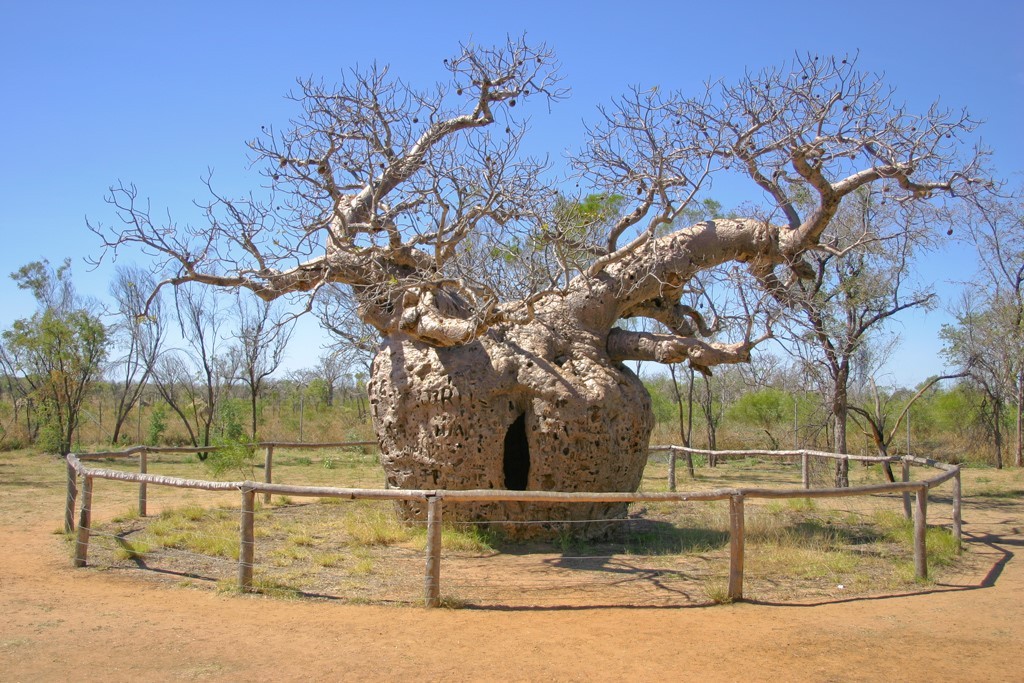Wrongly Imprisoned Tree

If you travel to the town of Derby in Western Australia, you will likely hear about its famous ‘Prison Tree’. This ancient boab tree has become quite popular among locals and tourists alike, becoming one the town’s biggest – if not the biggest – attraction.
This tree is most famous for being a significant part of Australian history and culture. According to its on-site description, this ‘Prison Tree’ is a representation of the treatment that prisoners received in north Australia during the late 19th and early 20th century. The story goes that this tree was even used as an Aboriginal prison, serving as a holding area or staging point for prisoners.
So why did it hit the news recently? As The Conversation reports, it turns out that the story of it becoming a ‘Prison Tree’ is just a myth, and there’s no evidence of the tree ever being used as a prison (or any form of imprisonment attributed to it).
On the upside, this ancient boab tree still retains its majestic size and presence despite all the controversies surrounding it. So while the stories around it may not be true, it is still truly a sight to behold.
Chopping Down History

A 170-year old giant bunya pine tree was recently cut down in Tasmania for safety reasons – a move that angered horticulturalists and historians, according to ABC News.
According to the news story, the tree was cut down because of the ongoing risk that its large, heavy pine cones presented to visitors and staff of the Tasmanian Catholic Education Office (TCEO) just below it.
So why did its cutting down anger historians and horticulturalists? Apart from being almost two centuries old, it turns out the bunya pine tree is not native to Tasmania.
Although it is native to Australia, it unfortunately does not normally grow in Tasmania because of the cool climate. In fact, it had been a significant horticultural achievement to have it grow there for so long. It has been estimated that there are probably only about a dozen or so of them throughout Tasmania, with many planted in the 19th century.
Landmark Tree Caught By Decay

Some trees become famous for being an integral part of Australian history, while others are recognised for being landmarks in well-loved areas.
Such was the case for a blue gum tree in front of the Halse Lodge in Noosa. Locals believe this tree was more than 100 years old, with photographs taken as early as 1910 available as proof.
According to a story by The Sunshine Coast Daily, the tree’s troubles started in 2007, when it started deteriorating from fungal decay. Since then, Drew Pearson of Halse Lodge had worked to prolong its life as long as possible. But by July 2016, independent arborists confirmed that its decay and damage were too much and that it posed considerable safety risks. Upon this confirmation, the local council then approved its removal.
It was an unfortunate end for this iconic gum tree, which has become a part of the memories of many locals and tourists throughout the past century. In fact, according to Mr. Pearson, the tree has appeared in the photographs of countless international backpackers who stayed at the lodge throughout the years.
As professional tree removalists, we know just how sad and unfortunate it can be to remove well-loved trees, especially those that have been around for ages. But whether we like it or not, nature will take its course, and issues like fungal decay can happen even to the most loved trees.
Art From Dead Wood

It’s one thing to make art from recycled wood, but it’s another to do it from wood that is more than a century old.
But that’s exactly what happened in Sydney last year when wood from old, historical trees was used to create beautiful works of art. A story by ABC News details how various artworks were constructed from wood that was salvaged from 50 trees that were felled because of disease, damage, or simply old age. Some of these trees were almost 200 years old and once stood over Sydney landmarks such as the Royal Botanic Garden, the Australian Botanic Garden, and the Blue Mountains Botanic Garden.
This initiative was part of the Treecycle project, which promotes recycling and conservation. As the news story reports, more than 40 artists took part in the project, and they ended up using over 20 species of wood. A shining example of their work was the violin that violin maker Mikey Floyd crafted out of an African olive tree. Other artwork made from this project included sculptures, furniture, and even toys.
As this story shows, it is not always all sad when trees are felled or removed. Sometimes, with a little initiative and creativity, you can also make something beautiful out of it.

